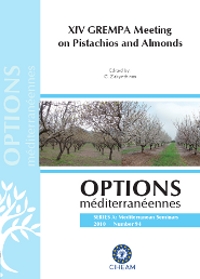| Article précédent | p. 235-243 | Article suivant |
Fruit quality in almond: chemical aspects for breeding strategies
Almond (Prunus amygdalus Batsch) kernel composition is a basic aspect for almond quality evaluation, but, with the exception of kernel taste, only nut and kernel physical traits have been considered so far in almond evaluation. Kernel bitterness, due to the presence of amygdalin, has been thoroughly studied from the physiological and genetic points of view, but not the other chemical traits, which, however, have a great importance in the organoleptic appreciation of the kernel, in its industrial utilization, in its keeping performance, and in its nutritional and healthy value. The major component of almond kernels is the lipid fraction, ranging from 35 to 70 percent of the total kernel dry weight. More important is the different proportion of the main fatty acids, with a predominant role of oleic acid, the most interesting from the nutritional and health point of view, ranging from 62 to 78 percent of the total fatty acids. Some confectioneries, such as nougat, require a high proportion of fatty acids whereas others, such as marzipan and almond flour, require a low proportion. Protein content ranges between 13 and 29 percent, being inversely proportional to the percentage of fatty acids. Soluble sugars range from 3 to 8 percent, with a predominant presence of sucrose. Ash residue ranges from 3 to 4.5 percent, with K, Ca and Mg as predominant elements. Fibre content ranges from 2 to 6 percent. Mostly interesting is the presence of tocopherols, due to their antioxidant activity. They are the source of vitamin E and also avoid, or retard, the rancidity process in almond kernels. Large differences in tocopherol content have been found between cultivars and selections, allowing an effective selection process for this trait in breeding programmes because of their implication in the industrial, nutritional and healthy value of the almond kernels. All these parameters are more or less heritable and must be considered in the design of crosses and in the evaluation during a breeding programme.
La composition de l'amandon est un aspect de base pour l'évaluation de la qualité chez l'amandier (Prunus amygdalus Batsch). Pourtant, à l'exception du goût de l'amandon, seuls les caractères physiques de la coque et de l'amandon ont été considérés pour le moment dans l'évaluation des cultivars d'amandier. Le goût amer, dû à la présence d'amygdaline, a été profondément étudié du point de vue physiologique et génétique, mais pas les autres caractères chimiques, qui ont malgré tout une grande importance pour l'appréciation organoleptique de l'amandon, pour son utilisation industrielle, son stockage, et sa valeur nutritive et favorable à la santé. La composante majeure de l'amandon est la fraction lipidique, qui va de 35 à 70 pour cent du total de son poids sec. Plus importante est la différente proportion des acides gras les plus présents dont l'acide oléique, qui représente 62 à 78 pour cent et qui est le plus intéressant du point de vue nutritif et de la santé. Quelques produits, comme le nougat, demandent une proportion élevée d'acides gras, mais d'autres, comme le massepain et la farine d'amande, en nécessitent une proportion faible. La teneur en protéine va de 13 à 29 pour cent, étant inversement proportionnelle à celle en acides gras. Les sucres solubles vont de 3 à 8 pour cent, avec une présence prédominante du saccharose. Le résidu de cendres va de 3 à 4,5 pour cent, avec K, Ca et Mg comme éléments prédominants. La teneur en fibre va de 2 à 6 pour cent. Très intéressante est la présence de tocophérols, étant donné leur activité anti-oxydante. Ils sont la source de la vitamine E et évitent, ou retardent, le processus de rancissement des amandons. De grandes différences dans la teneur en tocophérols ont été trouvées parmi les cultivars et les sélections, ce qui permet un processus de sélection effectif pour ce caractère dans les programmes d'amélioration génétique à cause de son implication pour la valeur industrielle, nutritive et de santé des amandons. Il faut considérer tous ces paramètres, qui sont plus ou moins héritables, dans la conception des croisements et dans l'évaluation d'un programme d'amélioration.
- [ Afficher ]
- [ Télécharger ]
- [ Exporter la citation ]
Vous pouvez télécharger la citation au format :
- [ Imprimer ]
-
Mots-clés
AMANDE, AMELIORATION GENETIQUE, COMPOSITION GLOBALE, FRUIT, PRUNUS DULCIS, QUALITE, VALEUR NUTRITIVECiter cet article
Socias i Company R., Kodad O., Alonso J.M., Font-Forcada C. Fruit quality in almond: chemical aspects for breeding strategies. In : Zakynthinos G. (ed.). XIV GREMPA Meeting on Pistachios and Almonds. Zaragoza : CIHEAM / FAO / AUA / TEI Kalamatas / NAGREF, 2010. p. 235-243. (Options Méditerranéennes : Série A. Séminaires Méditerranéens; n. 94). 14. GREMPA Meeting on Pistachios and Almonds, 2008/03/30-2008/04/04, Athens (Greece). http://om.ciheam.org/om/pdf/a94/00801309.pdf



